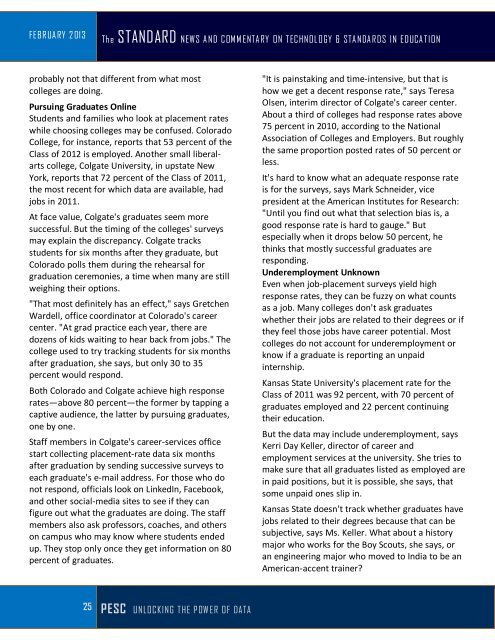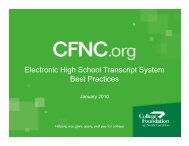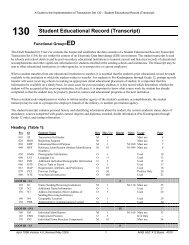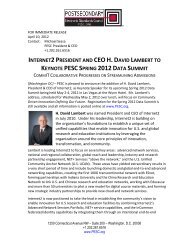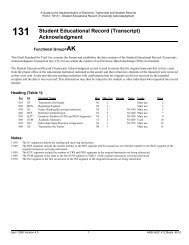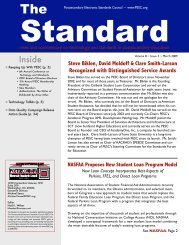February 2013 - PESC
February 2013 - PESC
February 2013 - PESC
You also want an ePaper? Increase the reach of your titles
YUMPU automatically turns print PDFs into web optimized ePapers that Google loves.
FEB RUA RY 2 013<br />
Th e STANDARD NEWS A ND C OM M ENTA RY ON T EC HNOL OGY & STA NDA RDS IN EDUCA T ION<br />
probably not that different from what most<br />
colleges are doing.<br />
Pursuing Graduates Online<br />
Students and families who look at placement rates<br />
while choosing colleges may be confused. Colorado<br />
College, for instance, reports that 53 percent of the<br />
Class of 2012 is employed. Another small liberalarts<br />
college, Colgate University, in upstate New<br />
York, reports that 72 percent of the Class of 2011,<br />
the most recent for which data are available, had<br />
jobs in 2011.<br />
At face value, Colgate's graduates seem more<br />
successful. But the timing of the colleges' surveys<br />
may explain the discrepancy. Colgate tracks<br />
students for six months after they graduate, but<br />
Colorado polls them during the rehearsal for<br />
graduation ceremonies, a time when many are still<br />
weighing their options.<br />
"That most definitely has an effect," says Gretchen<br />
Wardell, office coordinator at Colorado's career<br />
center. "At grad practice each year, there are<br />
dozens of kids waiting to hear back from jobs." The<br />
college used to try tracking students for six months<br />
after graduation, she says, but only 30 to 35<br />
percent would respond.<br />
Both Colorado and Colgate achieve high response<br />
rates—above 80 percent—the former by tapping a<br />
captive audience, the latter by pursuing graduates,<br />
one by one.<br />
Staff members in Colgate's career-services office<br />
start collecting placement-rate data six months<br />
after graduation by sending successive surveys to<br />
each graduate's e-mail address. For those who do<br />
not respond, officials look on LinkedIn, Facebook,<br />
and other social-media sites to see if they can<br />
figure out what the graduates are doing. The staff<br />
members also ask professors, coaches, and others<br />
on campus who may know where students ended<br />
up. They stop only once they get information on 80<br />
percent of graduates.<br />
"It is painstaking and time-intensive, but that is<br />
how we get a decent response rate," says Teresa<br />
Olsen, interim director of Colgate's career center.<br />
About a third of colleges had response rates above<br />
75 percent in 2010, according to the National<br />
Association of Colleges and Employers. But roughly<br />
the same proportion posted rates of 50 percent or<br />
less.<br />
It's hard to know what an adequate response rate<br />
is for the surveys, says Mark Schneider, vice<br />
president at the American Institutes for Research:<br />
"Until you find out what that selection bias is, a<br />
good response rate is hard to gauge." But<br />
especially when it drops below 50 percent, he<br />
thinks that mostly successful graduates are<br />
responding.<br />
Underemployment Unknown<br />
Even when job-placement surveys yield high<br />
response rates, they can be fuzzy on what counts<br />
as a job. Many colleges don't ask graduates<br />
whether their jobs are related to their degrees or if<br />
they feel those jobs have career potential. Most<br />
colleges do not account for underemployment or<br />
know if a graduate is reporting an unpaid<br />
internship.<br />
Kansas State University's placement rate for the<br />
Class of 2011 was 92 percent, with 70 percent of<br />
graduates employed and 22 percent continuing<br />
their education.<br />
But the data may include underemployment, says<br />
Kerri Day Keller, director of career and<br />
employment services at the university. She tries to<br />
make sure that all graduates listed as employed are<br />
in paid positions, but it is possible, she says, that<br />
some unpaid ones slip in.<br />
Kansas State doesn't track whether graduates have<br />
jobs related to their degrees because that can be<br />
subjective, says Ms. Keller. What about a history<br />
major who works for the Boy Scouts, she says, or<br />
an engineering major who moved to India to be an<br />
American-accent trainer?<br />
25 <strong>PESC</strong> UNLOC K ING T HE P OW ER OF DATA


